Space Image of the Day Gallery (May 2017)
Image of the Day Archives
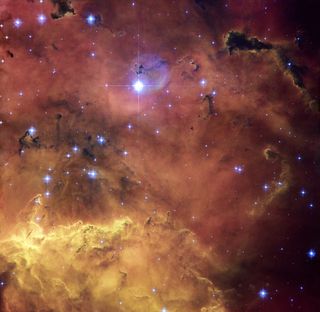
For older Image of the Day pictures, please visit the Image of the Day archives. Pictured: NGC 2467.
Interstellar Photobomb
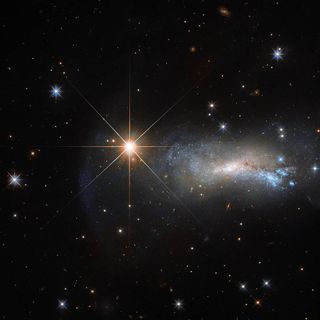
Monday, May 1, 2017: A bright star photobombs a distant galaxy in this newly released image from the Hubble Space Telescope. The galaxy, named NGC 7250, lies more than 45 million light-years from Earth. Because the star, named TYC 3203-450-1, is about a million times closer, it appears to outshine the entire galaxy from Hubble's perspective in Earth's orbit. If the star were just as far away as the galaxy, it would be hardly noticeable. — Hanneke Weitering
Touchdown!
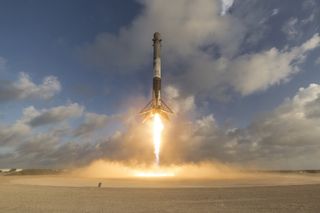
Tuesday, May 2, 2017: SpaceX nailed another upright rocket landing yesterday when its Falcon 9 booster touched down at Cape Canaveral Air Force Station in Florida after delivering a spy satellite into orbit. The classified satellite, titled NROL-76, is the first payload SpaceX has launched for the U.S. Department of Defense. — Hanneke Weitering
Telescopes Under the Milky Way

Wednesday, May 3, 2017: Zodiacal light and a shimmering Milky Way illuminate the night sky in this stunning panoramic view of the Very Large Telescope array (VLT). Located at the European Southern Observatory's remote facilities on the Cerro Paranal mountain in northern Chile, VLT isn't exposed to much light pollution. This makes the observatory not just a good place for telescope observations, but also for amazing astrophotography.— Hanneke Weitering
Cassini Swoops Through Saturn's Rings
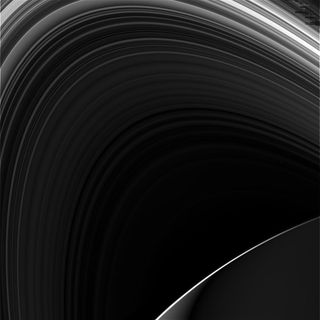
Thursday, May 4, 2017: Saturn's rings look absolutely spectacular in the latest photos from NASA's Cassini spacecraft. Cassini took its second dive through the gap between Saturn and its rings on Tuesday (May 2), and captured this raw image on the way out. — Hanneke Weitering
Snuggling Spacesuits
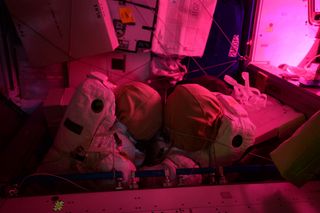
Monday, May 8, 2017: What may look like two astronauts embracing one another in space is actually two empty spacesuits stowed inside the International Space Station's Columbus module. Pink lighting from the greenhouse in Columbus adds a romantic ambiance to the scene. — Hanneke Weitering
An 'Old' North Pole
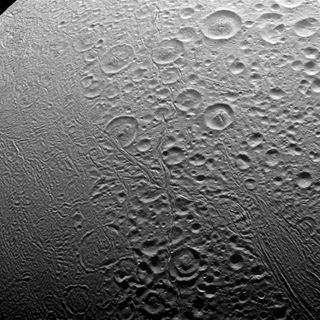
Tuesday, May 9, 2017: The north pole of Saturn's icy moon Enceladus doesn't look much different than Earth's moon with its battered surface. This close-up view from NASA's Cassini spacecraft reveals heavy cratering that suggests the surface of Enceladus is "about as old as any in the solar system," NASA officials said, because there are no signs of recent geologic activity here. Its south pole, on the other hand, is covered in "tiger stripe" fractures that spray vapor plumes into space, suggesting the surface is geologically active and relatively young. — Hanneke Weitering
Get the Space.com Newsletter
Breaking space news, the latest updates on rocket launches, skywatching events and more!
'Delicate Night Sky'

Wednesday, May 10, 2017: A bright and vivid Milky Way glistens over Delicate Arch, a natural sandstone structure in Arches National Park in Utah. Photographer Chris Pruzenski brought his cousin (pictured) to the park, which is known for having dark skies, for a private lesson in Astrophotography 101. — Hanneke Weitering
Northern Lights Over Europe

Thursday, May 11, 2017: Vivid blue and teal auroras loom over northern Europe in this photo taken from the International Space Station. The large city pictured in the foreground is Berlin. City lights in The Netherlands and Belgium glow brightly in the distance, while Norway and Sweden look relatively dim in comparison. — Hanneke Weitering
A 'Fishy' Starburst Galaxy
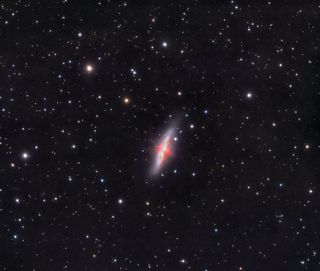
Friday, May 12, 2017: Messier 82, a bright galaxy rich with new star formation, looks a bit like a cosmic koi fish in this image by astrophotographer Jaspal Chadha. Located 12 million light-years away in the constellation Ursa Major, this galaxy is about five times more luminous than the Milky Way. It is also known as the Cigar Galaxy, or NGC 3034. — Hanneke Weitering
Galactic 'Siamese Twins'

Monday, May 15, 2017: These two conjoined galaxies are known collectively as the galaxy IRAS 06076-2139. They are actually separated by about 20,000 light-years and are whizzing past one another at a speed of about 1.2 million miles (2 million kilometers) per hour, warping each other's structures with the force of gravity along the way. NASA's Hubble Space Telescope captured this view of the galactic duo, which lies 500 million light-years away in the constellation Lepus (The Hare). — Hanneke Weitering
Join our Space Forums to keep talking space on the latest missions, night sky and more! And if you have a news tip, correction or comment, let us know at: community@space.com.

Space.com is the premier source of space exploration, innovation and astronomy news, chronicling (and celebrating) humanity's ongoing expansion across the final frontier. Originally founded in 1999, Space.com is, and always has been, the passion of writers and editors who are space fans and also trained journalists. Our current news team consists of Editor-in-Chief Tariq Malik; Editor Hanneke Weitering, Senior Space Writer Mike Wall; Senior Writer Meghan Bartels; Senior Writer Chelsea Gohd, Senior Writer Tereza Pultarova and Staff Writer Alexander Cox, focusing on e-commerce. Senior Producer Steve Spaleta oversees our space videos, with Diana Whitcroft as our Social Media Editor.
